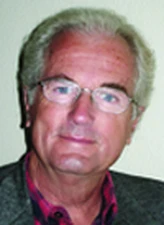Stefan M. Schmid

The 2009 Stephan Mueller Medal is awarded to Stefan M. Schmid for his outstanding contributions to the study of the structure and rheology of deformed rocks and the processes of mountain building, especially in Alpine-type mountain belts.
1. Scientific qualifications of the Nominee
Stefan Schmid is one of the pre-eminent earth scientists of our day. This claim is not made lightly and stems from the impact his research and teaching has made on the earth science community. His seminal contributions to the field of Tectonics and Geodynamics range from the rheology of rocks to the evolution of mountain belts. His approach is decidedly interdisciplinary, involving the integration of field work on rock structures with modern geophysics, isotope geochronology and stratigraphy. His goal has been to understand the physical processes of mountain building. It seems fitting to honour this scientist with the internationally renowned Stefan Mueller Medal of the EGU.
2. Discoveries, Insights and Life Work
The nominee is well known for his contributions to two different fields of the Earth Sciences: (1) the structure and rheology of deformed rocks; (2) the processes of mountain building, especially in Alpine-type mountain belts.
Schmid has been a pioneer in relating natural deformation to experimentally deformed rocks in the laboratory. In experiments conducted with colleagues at the Australian National University and Centre for Tectonophysics (Texas A & M) in the 1970s and 80s, Schmid established for the first time that ultrafine-grained limestone rock (mylonite) is deformable at very low effective viscosities due to the operation of diffusive processes at grain boundaries. This discovery allowed him to solve a century-old paradox concerning the mechanical stability of large thrust sheets above thin, subhorzontal layers of mylonite. Such structures are found in all mountain belts, including the Alps. Schmid went on to propose microstructural criteria for determining the shear sense in mylonitic rocks. These methods have become standard tools for reconstructing the kinematic history of mountain belts. Together with leading experimentalists in the USA and colleagues at the ETH in Zürich, Schmid then applied automated texture goniometry to relate crystallographic preferred orientation in quartz aggregates to the finite strain ellipsoid and the vorticity of deformation in mylonitic basement rocks. This work paved the way for the current use of textures as kinematic indicators and syntectonic geothermometers in naturally deformed rocks.
Schmid applied many of the methods above to reconstruct the history of the Alps. Together with students and colleagues, he has developed new hypotheses on the geodynamic evolution of the Alps, the Dinarides and the Carpathians. Beginning in the 1980s, Schmid clarified the relationship of late orogenic faulting in the Alps to the structure of the lower crust and upper mantle imaged in geophysical transects. His cross sections of the Alps have become standard references in the tectonics literature. Schmid’s work on the regional geology of the Alps is frequently combined with studies of orogenic processes; for example, the relationship of orogenesis to the intrusion of mantle-derived melt, the evolution of passive margins antecedent to orogenesis, and the exhumation of rocks subjected to very high pressure during subduction. In the tradition of Alpine geologists, Schmid has lent his experience to applied geology, specifically relating to brittle faults in railway tunnel construction in the Alps, and neotectonics and earthquake risk assessment in the upper Rhine graben area. His occasional work in other orogens (Himalayas, N. American Cordillera) have complimented his activities in European geology.
Schmid’s recent work has had a profound impact on the international tectonic community, particularly in Europe where his syntheses of Alpine-type mountain belts have opened up new and promising avenues of research.
Prof. S. Schmid is in the final stages of his career and is consolidating his research on the geodynamics of Alpine-type orogens in Europe. He is pursuing work in the Alps-Carpathians-Dinarides system of orogens, particularly in the Dinarides where his research group will remain active. For the future, Schmid is interested in comparing the evolution of Alpine-type orogens with other orogens, as presented in some of his talks at recent meetings.
